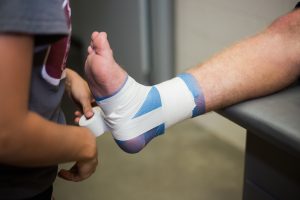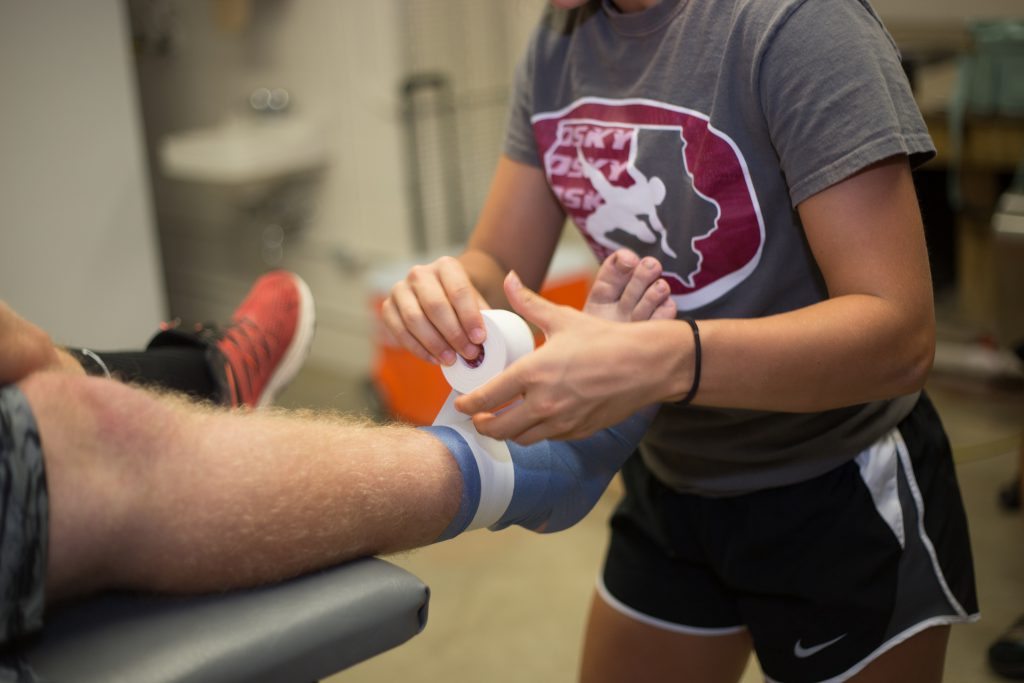by Dr. Troy Vander Molen, PT, DPT
Athletic taping for various conditions has become an extremely popular and somewhat controversial topic over the past few years. There is no doubt that new products have gained great popularity over the years. Do you remember the Olympics and all the colorful tape products adorning so many athletes? The use of flexible taping products has become a fashion statement almost more than an injury preventer or performance enhancer.
Many assume since Olympic athletes use tape, they should too. With the start of winter seasons, we’re frequently asked about taping ankles for basketball and wrestling. So let’s dispel myths you might have heard about taping to keep your student-athletes’ ankles safe and feeling good!
Ankle Injury Myths
-
Myth #1: Athletic taping is a new, trendy practice.
Though there are many new, trendy taping products available today, traditional athletic tape has been used for decades to enhance stability and control ankle mobility. For years it was a practice reserved for people experiencing an ankle sprain or chronic ankle instability. Even the “newer” flexible taping products were originally invented in the 1970s by Japanese chiropractor Kenzo Kase.
-
Myth #2: I should lay off my ankle after injuring it.
How you treat your ankle injury depends upon the nature and the significance of the injury. However, the research is clear: early movement is critical to enhancing the healing process after tissue injury. Initially immobilization of the ankle may be required, but movement via active range of motion is beneficial. That movement must be controlled to prevent unnecessary stress on the healing tissue. With many ankle sprains, the stability provided by ankle taping reduces stress on those healing tissues. You should be able to function with less pain and move more safely.
-
Myth #3: Taping my ankles should mask my pain.
The use of athletic tape should never be done to mask pain, though it can certainly reduce it. If you are taped up and still experience pain with functional performance, you could still be damaging tissue and interrupting the healing process. You should also understand that athletic tape loses some degree of support when it experiences the stresses of movement. The tension of the tape wears down and the supportive effects are minimized somewhat. Therefore, a re-application of tape may be necessary.
-
Myth #4: Ankle braces are better than ankle taping.
Some people will choose to use an ankle brace instead of tape. I can understand why people consider this option. A brace can be more quickly applied without the help of someone skilled at ankle taping. Ankle taping can also cause skin irritation, and no one likes that. However, ankle bracing has its cons too. Braces are usually bulker and may be hard to fit inside an athletic shoe. Because of this, some people find braces to be less comfortable than athletic tape.
-
Myth #5: Taping my ankles makes me more susceptible to injury of other lower extremity joints.
There is no evidence that taping or bracing makes you more susceptible to injuries further up the leg. Additionally these taping interventions don’t weaken ankles or make you more susceptible to ankle sprains in the future. I do encourage people to eliminate the extra support when the body is ready to support itself. This helps stimulate the body’s proprioceptive system (see Myth #6) used to enhance balance.
-
Myth #6: Taping or bracing my ankles is a good proactive measure to prevent injury.
Over the years, I have seen many people – particularly volleyball players – use ankle braces preventatively. In other words, there’s no history of ankle problems but a brace is used to prevent an injury. Because the body uses proprioception, neurological feedback from tissue movement to engage muscles, I don’t recommend using either athletic tape or braces if you’ve never had an ankle problem. Even if you’re double-jointed, clumsy or feel weak, it would be best to develop the neuromuscular skills to prevent problems than to rely on external support.
-
Myth #7: Flexible taping (like Kinesio Tape, Rock Tape, and Spider Tape) are a good solution to ankle sprains.
These “magic tapes” are definitely all the hype right now. If you aren’t familiar with flexible taping products, these tapes have elastic properties that mimic the flexible properties of human skin. This means that they allow for some “recoil” or pull force on the skin and underlying tissues. The most current research indicates, though, this intervention can help in two ways: swelling reduction and pain relief. However, flexible tape does not enhance performance, and – this is important – it does not provide the stability that many ankles require, particularly when attempting to compete while tissues are still healing.
Conclusion
If you want to learn more about kinesiology taping take a look at a previous article on taping.
 So, are you best off taping your ankle, bracing your ankle, or leaving it be? Like most things, it depends. If you are unsure about what is best for your individual circumstances, consult with your athletic trainer or physical therapist to find out which option is best for you.
So, are you best off taping your ankle, bracing your ankle, or leaving it be? Like most things, it depends. If you are unsure about what is best for your individual circumstances, consult with your athletic trainer or physical therapist to find out which option is best for you.
Get the Help You Need
We love being your resource for musculoskeletal issues, so once again we are going to make it easy for you to get the help you need without cost or obligation. If you have a history of ankle problems – whether you’re a current or former athlete – simply call into our office at 866-588-0230 or email us and get scheduled for a brief, free screening. It will only take 20 minutes of your time, and you could find out something that saves you both money and pain.




